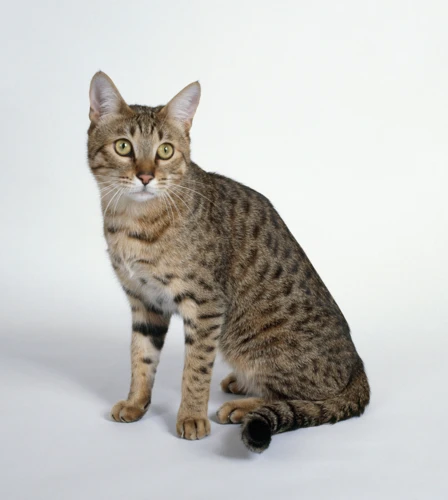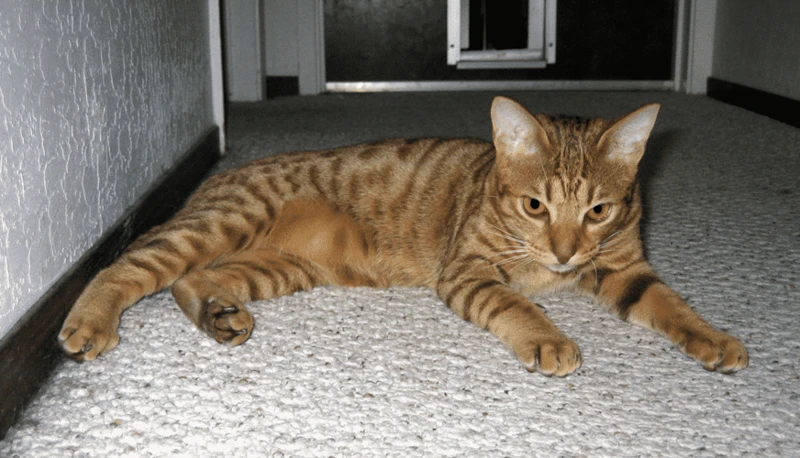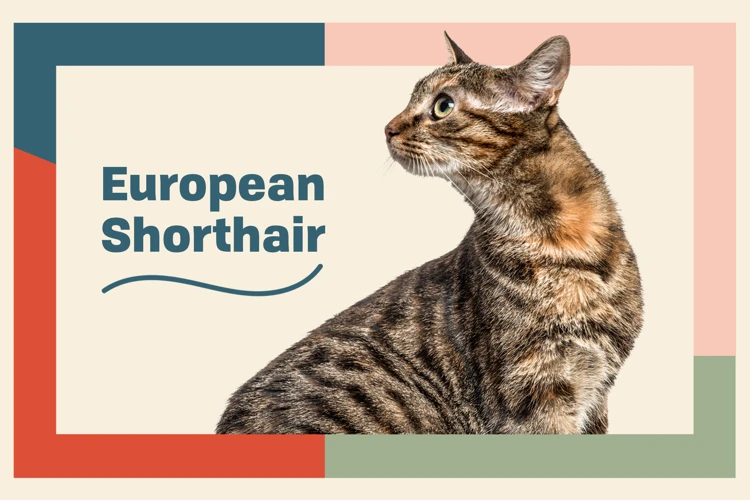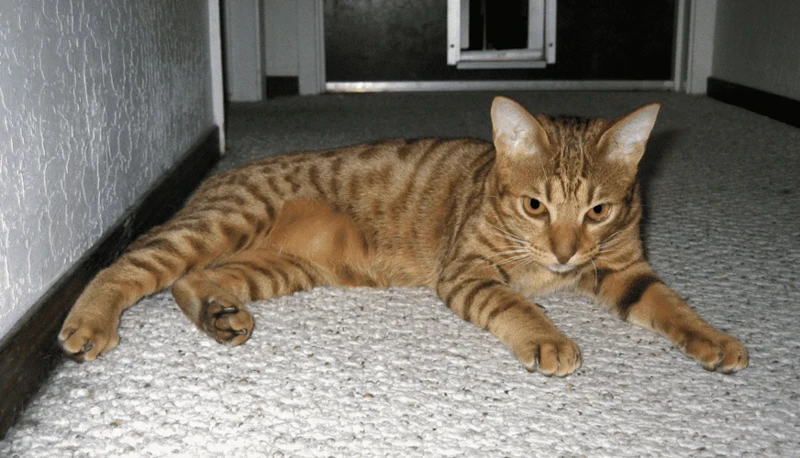As a California Spangled cat owner, trying to figure out the best way to train your furry friend can be a perplexing task. With so many training methods available, it’s difficult to decide what approach to take. However, one method that has been proven to be effective is positive reinforcement. Using positive reinforcement in training promotes good behavior and strengthens the human-animal bond. Plus, it’s a fun and engaging way to train your California Spangled. In this article, we will go through the benefits of positive reinforcement training for your California Spangled, how to implement it, common techniques, and challenges you might face along the way.
What is Positive Reinforcement?

Positive reinforcement involves rewarding desirable behavior of an animal to increase the likelihood of that behavior occurring again in the future. It is a training method where the owner offers something desirable to their pet to encourage them to repeat a specific action. This technique has been used widely in the training of various animals, including California Spangled cats.
The fundamental principle behind positive reinforcement is that animals are more likely to repeat a behavior when it results in something beneficial. By using positive reinforcement techniques, the owner can reward their cat’s good behavior. This can be done through a variety of means, including treats, verbal praise, or playtime, depending on what the cat prefers.
When an owner uses positive reinforcement, the cat will learn to associate the wanted behavior with a positive outcome. The desired behavior does not necessarily have to be complicated or complex – it could be something as minor as sitting still or remaining calm during grooming.
Positive reinforcement has proven to be an effective technique for training California Spangled cats over other methods such as punishment or negative reinforcement. Positive reinforcement builds trust and a stronger connection between owners and their cats. It creates an environment where the pet feels comfortable, confident, and more likely to repeat positive behavior instead of avoiding negative ones.
In the next sections, we will delve further into the techniques of positive reinforcement and how to effectively utilize them in the training of California Spangled cats.
How Positive Reinforcement Works?
Positive reinforcement works by rewarding desired behaviors with something that the California Spangled enjoys. When your cat receives a reward, such as a treat or toy, they are more likely to repeat the behavior that prompted the reward. This is because they associate the behavior with a positive outcome and want to continue receiving the reward.
For example, if you are training your California Spangled to sit, you can use positive reinforcement by giving them a treat each time they sit on command. This will help them learn that sitting on command results in a positive outcome, making it more likely that they will continue to sit on command in the future.
Positive reinforcement is effective because it teaches your California Spangled what to do rather than what not to do. It focuses on rewarding desirable behaviors rather than punishing undesirable ones. By utilizing positive reinforcement, you can create a more positive and enjoyable training experience for both you and your cat.
Positive reinforcement can also help alleviate problem behaviors in your California Spangled by redirecting their attention towards more desirable behaviors. Instead of punishing your cat for engaging in unwanted behaviors, you can redirect their behavior by rewarding them when they engage in a desirable behavior. For example, if your California Spangled is scratching the furniture, you can redirect their attention by giving them a scratching post to scratch on and rewarding them when they use it.
Positive reinforcement is a powerful training tool that can help you teach your California Spangled new behaviors and reinforce desirable ones. Incorporating positive reinforcement techniques into your training regimen can help strengthen your bond with your cat and make the training process more enjoyable. For more information on positive reinforcement for California Spangled training, please visit california-spangled-positive-reinforcement.
Why Use Positive Reinforcement for California Spangled Training?

Positive reinforcement is a powerful tool that can be used for training California Spangled cats. Not only is it effective, but it also has several benefits that make it a popular choice amongst pet parents and trainers alike.
One of the biggest benefits of positive reinforcement is that it encourages good behavior. When your California Spangled cat exhibits a desired behavior, rewarding it with treats or praise reinforces that behavior and increases the likelihood that it will happen again in the future. This means that positive reinforcement can be used to teach your cat new tricks, such as sitting or rolling over, as well as to discourage negative behaviors, such as scratching furniture or aggression towards other animals.
Another advantage of positive reinforcement is that it strengthens the bond between you and your California Spangled cat. By rewarding good behavior, you not only communicate to your cat what you want it to do, but you also show it that you appreciate and care for it. This leads to a more trusting and affectionate relationship between you and your pet.
Positive reinforcement can also help to reduce stress and anxiety in California Spangled cats. Punishment-based training techniques can be stressful and intimidating for cats, which can lead to a breakdown in communication and damage to the human-animal bond. On the other hand, positive reinforcement creates a stress-free and enjoyable learning environment, which can help to alleviate any negative emotions your cat may be experiencing.
Lastly, positive reinforcement keeps training fun and engaging for California Spangled cats. Since your cat is being rewarded for good behavior, it doesn’t feel like it’s being forced to do anything and therefore enjoys the learning process. This can help to maintain your cat’s interest and motivation, making training sessions more effective and efficient.
Positive reinforcement is a highly effective, stress-free, and enjoyable training technique that can be used for California Spangled cats. By focusing on rewarding good behavior, it creates a strong human-animal bond, increases motivation, and reduces stress and anxiety. If you’re interested in learning more about how you can use positive reinforcement to train your cat, check out our article on clicker training or read about the differences between positive reinforcement and punishment.
Encourages Good Behavior
Using positive reinforcement in California Spangled training can encourage good behavior in your feline friend. This method of training involves rewarding your cat for desired behaviors, such as using the litter box or scratching on a designated post. When your cat is rewarded for good behavior, they are more likely to repeat it in the future. This repetition leads to a habit of good behavior, making your cat a well-behaved and happy pet.
For example, let’s say you want to train your California Spangled to jump through a hoop. Using positive reinforcement, you would first reward your cat for any action towards the hoop, such as moving closer or sniffing it. Then, as your cat gets closer to jumping through the hoop, you can increase the criteria for the reward until finally, your cat successfully jumps through the hoop and receives a larger reward.
With positive reinforcement, your California Spangled will start to associate good behavior with positive consequences. This creates a strong incentive for them to behave well in the future. It also helps prevent unwanted behavior by redirecting your cat’s attention towards desired actions and making them more likely to repeat these behaviors in the future.
Ultimately, positive reinforcement is a powerful tool that can help you build a loving and obedient relationship with your California Spangled. By rewarding good behavior, you can encourage your feline friend to become a well-behaved and happy member of your family. For more information about using positive reinforcement techniques with your California Spangled, check out our article “How to Use Positive Reinforcement to Correct Behavioral Issues in Your California Spangled”.
Strengthens Human-Animal Bond
Positive Reinforcement training techniques are a wonderful way to strengthen the bond between California Spangled cats and their owners. As we use rewards to encourage good behaviour, kittens begin associating treats and praise with certain actions and tasks. This leads to a natural reinforcement of mutual trust and affection between the animal and its human companion.
When you use Positive Reinforcement, both you and your cat enjoy the process of learning new things together, without the stress and fear that comes with punishment-based methods. Instead of being afraid of making mistakes, cats feel encouraged to try new things and interact more with their surroundings. This aligns with their natural curiosity and playfulness, making learning processes enjoyable and memorable.
Positive Reinforcement also creates a positive atmosphere around the cat, and it is contagious. As the cat learns to trust you, it is also encouraged to interact with your family and other pets in a friendly and playful manner, rather than reacting defensively or out of fear. This, in turn, strengthens the bond and fosters a relaxed and calm atmosphere within the household.
Consequently, implementing Positive Reinforcement techniques can lead to a more satisfying and enjoyable relationship between owners and their California Spangled cats. Over time, as the bond between you and your pet grows stronger, you’ll have a furry friend for life.
Reduces Stress and Anxiety
Training can be a stressful experience, not just for California Spangled cats, but also for their owners. The use of positive reinforcement can help reduce stress and anxiety for both parties. Punishing bad behavior can cause fear and anxiety in the cat, whereas rewarding good behavior encourages a positive association with training. This is because when a cat is rewarded with a treat or toy for good behavior, it releases dopamine, which is a natural hormone that makes them feel happy. This helps to reduce any stress and anxiety they may have been feeling during the training process.
In addition to reducing stress and anxiety in California Spangled cats, positive reinforcement can also help to reduce stress and anxiety in their owners. This is because it can be frustrating when a cat does not behave as desired during training, and using punishment may cause anger and resentment towards the cat. On the other hand, rewarding good behavior can foster a positive relationship between owner and cat, leading to a happier and more fulfilling training experience.
Positive reinforcement can also help to reduce stress and anxiety outside of the training context. Since cats can be trained to perform certain behaviors with the use of positive reinforcement, such as using a litter box or staying off the furniture, this reduces stress for owners by eliminating the need for constant monitoring and scolding. Knowing that their California Spangled is following desired behaviors can also lead to less stress and worry when leaving them alone in the house, as owners can trust that they will not engage in destructive or unwanted behaviors.
The use of positive reinforcement for training California Spangled cats can be incredibly beneficial in reducing stress and anxiety for both owner and feline. By fostering a positive and happy environment, both parties can enjoy the training experience and build a stronger bond.
Keeps Training Fun and Engaging
Training your California Spangled can be a challenging task, but with positive reinforcement, it can become a joyful experience both for you and your feline companion. One of the benefits of utilizing positive reinforcement techniques during training is that it keeps the process fun and engaging.
Cats, like humans, are more motivated to learn when they are having fun. By using positive reinforcement techniques, you can make the training sessions more enjoyable for your California Spangled. Praise, treats, and toys can be effective rewards for positive behavior, and they can help maintain the cat’s motivation and enthusiasm during training.
Training can also be used as a bonding experience between you and your California Spangled. Spending time together and working towards a common goal can increase the bond between you and your feline friend. Positive reinforcement techniques foster trust and mutual respect between you and your cat, which improves your relationship outside of training sessions.
Using positive reinforcement for training creates a positive mindset around learning. It removes the fear factor associated with punishment and negative reinforcement techniques. This positive approach encourages the cat to experiment and learn new things without feeling threatened or anxious. They will be more open and receptive to learning when they know that training will be a fun and rewarding experience.
When training your California Spangled, keeping it fun and engaging is crucial to maintain motivation and enthusiasm. By using positive reinforcement techniques, you can make the learning process enjoyable, foster a strong bond with your cat, and promote a positive mindset towards learning. It is a win-win situation for both you and your furry friend.
How to Implement Positive Reinforcement in California Spangled Training?

To implement positive reinforcement in California Spangled training, it is important to follow a few key steps.
Identify Desired Behaviors: Start by identifying the behaviors that you want to reinforce. This can include behaviors such as coming when called, sitting on command or using the litter box. Clearly define the behaviors so that you can identify when they occur.
Choose Rewards: Once you have identified the desired behaviors, choose rewards that will motivate your California Spangled cat. This can include treats, toys or verbal praise. Make sure that the rewards are something that your cat enjoys.
Timing is Everything: When using positive reinforcement, timing is everything. Make sure to reward your cat immediately after they exhibit the desired behavior. This helps to reinforce the behavior and increases the likelihood that it will be repeated in the future.
Avoid Punishment: One of the key principles of positive reinforcement is to avoid punishment. Punishing your cat for unwanted behavior can cause stress and anxiety which can lead to more behavior problems. Instead, focus on rewarding the desired behavior which will encourage your cat to repeat it.
By following these steps, you can effectively implement positive reinforcement in California Spangled training. Remember to be patient and consistent with your training. Over time, you will begin to see the benefits as your cat becomes more well-behaved and responsive to your commands.
Identify Desired Behaviors
Identifying desired behaviors is the first step towards implementing positive reinforcement techniques in the training of your California Spangled. It is important to understand that positive reinforcement focuses on rewarding desirable behavior, rather than punishing undesirable behavior.
To begin with, you need to have a clear understanding of what behaviors you want to encourage in your cat. This could be anything from using the litter box, scratching only on designated surfaces, or coming to you when called. Once you have identified the specific behaviors that you want to reinforce, you can start planning the training process.
Observation is key when it comes to identifying desired behaviors in your California Spangled. Watch your cat’s behavior closely and take note of any actions or activities that align with your goals. For instance, if your goal is for your cat to use the litter box, you should pay attention to when your cat naturally goes to the box, and reward that behavior.
Be specific when identifying the desired behaviors, as it will help you in determining the appropriate rewards and ensuring consistency in your training approach. For example, rather than simply rewarding your cat for using the litter box, you can reward them for using it every time they need to eliminate.
Set achievable goals. Don’t expect your cat to learn everything overnight. Start with one or two behaviors at a time and gradually move on to others as your cat masters them. Breaking down the training process into smaller steps will make it easier for both you and your cat to stay motivated and avoid getting overwhelmed.
Identifying desired behaviors is a crucial factor in training your California Spangled using positive reinforcement. It requires careful observation, specificity, and setting achievable goals. Keeping these points in mind will help you in designing a successful training program that strengthens the bond between you and your furry friend.
Choose Rewards
Positive reinforcement involves rewarding your California Spangled for exhibiting desired behaviors. However, not all rewards are created equal. When choosing rewards, it’s important to consider what your cat values the most.
Food is often an effective reward for California Spangled cats. You can give your cat their favorite food or treat to reinforce good behavior during training. It’s important to choose a quality treat that is both healthy and tasty for your cat.
Toys can be another effective reward for cats, especially those who are toy-driven. Playing with your cat can be a great way to bond and reward good behavior. Make sure to choose toys that are safe and appropriate for your cat’s age and temperament.
Praise and Affection can also be powerful rewards for your cat. Many cats love attention and affection from their owners. You can praise your cat with verbal cues like “good job” or petting and cuddling to reinforce desired behaviors.
It’s important to note that rewards should be tailored to your cat’s individual personality and likes. Some cats may prefer food while others may be more motivated by toys or attention. It’s also important to keep rewards consistent so that your cat knows what to expect and can continue to exhibit good behavior.
Incorporating a variety of rewards can also help keep training sessions interesting and engaging for your cat. By choosing the right rewards for your cat, you can increase the effectiveness of positive reinforcement and help your California Spangled succeed in their training.
Timing is Everything
When it comes to training your California Spangled using positive reinforcement, timing is everything. This means that you need to reward your cat immediately after they exhibit the desired behaviour. This is because cats have a very short attention span, and if you delay the reward, they might not associate it with the behaviour you are trying to reinforce.
For example, if you are teaching your cat to sit on command, you should reward them as soon as they sit down. If you wait too long, they might get up and wander off, causing confusion as to what the reward was for.
Additionally, it’s important to always use positive reinforcement rather than punishment. Cats don’t respond well to punishment, and it can lead to fear and stress. Instead of punishing bad behaviour, try to redirect the behaviour towards something positive and immediately reward the desired behaviour.
Another thing to keep in mind is that you should be consistent with your timing. If you sometimes reward your cat immediately and other times you delay the reward, this can be confusing for your cat and hinder their progress in learning positive behaviours.
In order to ensure that your California Spangled is successful in their training using positive reinforcement, it’s important to be consistent with the timing of rewards and always focus on rewarding positive behaviours in a timely and consistent manner.
Avoid Punishment
While positive reinforcement involves rewarding desired behaviors, you should avoid using punishment or negative reinforcement to discourage unwanted behavior in your California Spangled. Punishment can include physical reprimands such as hitting your cat, or verbal reprimands such as shouting or scolding.
Not only is punishment cruel, it is also ineffective in the long term. Your cat may become afraid or aggressive, and the punishment may damage your bond with them. Punishing unwanted behavior does not teach your cat what behavior you actually want from them.
Instead, focus on ignoring unwanted behavior and rewarding desired behaviors through positive reinforcement. If your cat is scratching the furniture, for example, avoid yelling at them and instead redirect their attention to a scratching post. When they use the scratching post, lavish them with praise and treats.
It’s important to note that avoiding punishment also means avoiding techniques like spray bottles or shock collars, which can cause physical harm and emotional trauma to your cat. In the end, positive reinforcement is a more humane and effective way to train your California Spangled.
Common Positive Reinforcement Techniques for California Spangled Training

Using positive reinforcement techniques for California Spangled training can be an effective way to encourage good behavior and build a strong bond with your feline friend. Here are some common positive reinforcement techniques that can be used:
Clicker Training: This popular training method involves using a clicking sound to indicate when the desired behavior has been done correctly. This is often followed by a treat to reinforce that positive behavior. Clicker training can be particularly useful for teaching tricks and complex behaviors.
Treats and Toys: This is one of the most straightforward approaches to positive reinforcement and often one of the most effective. By rewarding your California Spangled with a treat or toy after displaying desired behavior, you can quickly teach them what is expected of them and keep them motivated.
Verbal Praise and Affection: Verbal praise, such as using encouraging words like “good job” or “well done,” can be just as effective at reinforcing positive behavior as treats or toys. Additionally, providing your cat with physical affection, such as petting or playing with them, can help build a stronger bond between you and your cat.
Crate Training: Crate training can be a useful technique for a variety of reasons including potty training, teaching your California Spangled to spend time alone, and for safety when traveling. By using positive reinforcement techniques such as treats, toys, and praise when your cat successfully enters and exits the crate, they can quickly learn to enjoy spending time in it.
It’s important to remember that different cats respond differently to different training methods, so it’s a good idea to experiment with different techniques to see which ones work best for your California Spangled. Consistency is key, no matter which approach you take. By using positive reinforcement techniques consistently and rewarding good behavior, you’ll be able to create an environment that encourages your cat to learn and grow.
Clicker Training
Clicker training is a popular form of positive reinforcement used for California Spangled cat training. This method involves using a small handheld device that makes a clicking sound when pressed. The sound is used to signal to the cat that they have performed the desired behavior and will be rewarded. Clicker training is a highly effective and efficient way to train cats because it allows for clear communication between the owner and the cat, making it easier to teach new behaviors.
Advantages of Clicker Training
One of the main advantages of clicker training for California Spangled cats is that it can be used to teach a wide variety of behaviors. From simple commands like “sit” and “stay” to more complex tricks like “roll over” and “play dead,” clicker training can help cats learn a range of new skills. This method also allows owners to target specific behaviors they want their cats to exhibit, such as using the litter box or scratching only on designated surfaces.
Another advantage of clicker training is that it reinforces positive behavior without the need for physical coercion or force. Using the clicker and rewards system, owners can encourage their California Spangled cats to exhibit good behavior by rewarding them with something they enjoy, like a treat. This positive reinforcement creates a sense of trust between the cat and the owner, which can lead to a deeper bond and improved behavior overall.
How Clicker Training Works
Clicker training works by creating a clear and distinct signal for the cat to associate with good behavior. When the cat performs the desired behavior, such as sitting or coming when called, the owner presses the clicker to create a sharp and distinct clicking sound. This sound tells the cat that they have done something right and will be rewarded.
After clicking the clicker, the owner then gives the cat a treat or other positive reinforcement, like praise or playtime. Over time, the cat comes to associate the clicking sound with positive outcomes and learns to repeat the desired behavior in order to receive a reward. This process reinforces good behavior and can help cats learn new skills quickly and efficiently.
Implementing Clicker Training
To implement clicker training with your California Spangled cat, you will need a clicker and some treats or rewards. Start by introducing the clicker to your cat and clicking it several times, followed by a treat. This will help your cat learn to associate the sound with the reward.
Next, identify a behavior you want to teach your cat and wait for them to perform it. As soon as they exhibit the behavior, click the clicker and give them a treat. Repeat this process multiple times until your cat has learned the behavior and responds consistently to the clicker.
As your cat learns new behaviors, you can start to shape their behavior by clicking and rewarding smaller steps toward the desired behavior. This method can help your California Spangled cat learn more complex tricks and behaviors over time.
Conclusion
Clicker training is an effective and humane way to train California Spangled cats. By using positive reinforcement and clear communication, owners can teach their cats new skills and improve their behavior. With patience and consistency, clicker training can help make training your cat a fun and rewarding experience for both you and your furry friend.
Treats and Toys
Using treats and toys can be an effective positive reinforcement technique for training your California Spangled cat. Treats are a great motivator for cats and can be used to encourage good behavior. When selecting treats, make sure they are healthy and contain high-quality ingredients. Avoid using cheap treats because they can be harmful to your cat’s health. Offer treats that are small and easy to eat, so your California Spangled doesn’t get too full.
Toys are another great positive reinforcement tool to use during training. Playing with your cat is a fun and engaging way to reward them for good behavior. Toys that encourage physical activity, such as chasing or jumping, can be particularly effective. Interactive toys, such as puzzle toys or food dispensers, can also be a great way to train your cat. They encourage mental stimulation and can help prevent boredom and destructive behavior.
It’s important to remember that treats and toys should be used in moderation and not rely on them as the sole means of positive reinforcement. Overusing treats can lead to weight gain in your California Spangled, and over-reliance on toys can lead to a lack of focus during training sessions. It’s a good idea to mix up the rewards you offer to keep things interesting for your cat and to prevent them from becoming bored.
When using treats and toys as positive reinforcement, it’s important to use them at the right time. Offer the treat or toy as soon as your California Spangled cat exhibits good behavior, so they understand what they are being rewarded for. Use a high-pitched tone of voice to show excitement and praise your cat when you offer the reward. This helps to reinforce the positive behavior and encourages your cat to continue with good behavior.
Using treats and toys as part of positive reinforcement during training can be a fun and effective way to teach your California Spangled new behaviors. Remember to use them in moderation and mix them up to keep things interesting, and offer them at the right time to reinforce good behavior. By doing so, you can help to strengthen your bond with your cat and create a happy, well-behaved feline companion.
Challenges and Solutions
When it comes to positive reinforcement training for California Spangled cats, there may be some challenges that pet owners might face along the way. However, there are also solutions that can help overcome these challenges.
Expectations of Immediate Results – One of the biggest challenges that cat owners may face when using positive reinforcement training is the expectation of immediate results. Although positive reinforcement is an effective training method, it does take time and patience to see results. Pet owners should understand that training is an ongoing process, and it is important to be consistent, patient, and persistent when training your California Spangled cat.
Adapting Rewards to Environment and Progress – Another challenge that pet owners may face is adapting the rewards to the environment and progress of your California Spangled cat. While treats and toys are excellent rewards for good behavior, the type of reward that your cat responds to may change over time. Pet owners must continually evaluate their cat’s progress, observe their behavior, and choose rewards that will motivate their cat to perform the desired behavior. Additionally, rewards should be adjusted according to the environment and specific situation in which the training is taking place.
By recognizing these challenges, pet owners can take steps to overcome them. By being patient and persistent, and by adapting rewards to the environment and progress of their cat, owners can continue to use positive reinforcement techniques to train their California Spangled cat effectively.
Expectations of Immediate Results
It’s natural to expect immediate results when it comes to training your California Spangled cat with positive reinforcement techniques. However, it’s important to understand that every cat is different in terms of their learning speed and behavior. It’s essential to avoid having unrealistic expectations in this process.
Many cats require time to learn desired behaviors, even with positive reinforcement. The timeline for training your California Spangled will vary depending on their age, personality, and previous training experiences. Some cats may take longer to learn behaviors than others, but with patience, consistency, and positive reinforcement, you will see progress.
It’s important to remember that cats have a short attention span, and focusing on training for too long will only cause them to lose interest. Short and frequent training sessions are more effective than long ones. You can keep the training sessions interesting by changing rewards, behaviors, and locations. This will keep your California Spangled excited and motivated to learn.
Staying consistent in training is key to seeing positive results. If you keep changing your training methods, it may confuse your cat and slow down their learning speed. Consistency in both the desired behavior and rewards being offered will help your California Spangled understand what’s expected from them and make the learning process more efficient.
It’s important to understand that it takes time to train your California Spangled with positive reinforcement techniques. Patience, consistency, and short but frequent training sessions are key to seeing positive results. Avoid having unrealistic expectations and stay consistent in your approach to see the long-term benefits of positive reinforcement training.
Adapting Rewards to Environment and Progress
As with any training program, it’s important to adapt the rewards you use to your California Spangled’s environment and progress. What works one day might not be effective the next, and it’s up to you as their owner to adjust your approach. This is especially true when it comes to choosing rewards.
Environmental Factors
Depending on where your California Spangled is training, certain rewards may not be possible or may not be as effective. For example, if you’re training outside, using treats as a reward might not work as well as it does indoors. There may be distractions like other animals or people, and the treats might get lost in the grass or dirt. Instead, consider using praise or a toy that your cat loves to play with.
If you’re training in a noisy environment, like a busy street, your cat might not be able to hear a clicker. In this case, you could try using a different type of sound, like a whistle or a snap of your fingers. It’s important to adapt the rewards you use to the environment you’re training in, so that your California Spangled remains engaged and motivated.
Progression
In addition to adapting rewards to the environment, you should also adapt them based on your cat’s progress. As your cat becomes more skilled at a particular behavior, they may become less interested in the original reward.
For example, if you’ve been using a particular toy as a reward for a behavior and your California Spangled starts to lose interest in it, it’s time to switch things up. Try a different toy or treat that they haven’t had before. You can also try increasing the level of difficulty for the behavior, which will keep your cat challenged and engaged.
It’s important to keep in mind that every cat is different, so what works for one might not work for another. You should be prepared to experiment with different rewards, both in terms of environment and progression, until you find what works best for your California Spangled. And remember, positive reinforcement is all about keeping things fun and engaging for your cat– so don’t be afraid to get creative!
Conclusion
In conclusion, positive reinforcement has numerous benefits for training your California Spangled. By rewarding good behavior, you are encouraging your cat to repeat those actions and strengthening your bond with them. Additionally, positive reinforcement can reduce stress and anxiety in your cat and keep training fun and engaging. However, it is important to properly implement positive reinforcement by identifying desired behaviors, choosing appropriate rewards, timing the rewards correctly, and avoiding punishment.
Common positive reinforcement techniques such as clicker training and using treats and toys can be effective in training your California Spangled. However, it is important to remember that every cat is unique and may require different approaches to training.
One challenge of positive reinforcement training is the expectation of immediate results. It is important to be patient and consistent in your training efforts, as progress may take time. Additionally, adapting rewards to your cat’s environment and progress can ensure continued success in training.
Overall, positive reinforcement is a humane and effective method for training your California Spangled. By using rewards to encourage desired behaviors, you can create a positive and enjoyable experience for both you and your furry companion.
Frequently Asked Questions
What is the California Spangled breed?
The California Spangled is a domestic cat breed that was first developed in the 1980s in California, United States, to resemble wild cats like the leopard and ocelot.
What is positive reinforcement?
Positive reinforcement is a training method that uses rewards or incentives to encourage and reinforce desired behavior in an animal.
How does positive reinforcement work?
When a behavior is followed by a positive consequence, such as a treat or praise, the animal is more likely to repeat the behavior in the future.
What are the benefits of using positive reinforcement for California Spangled training?
Positive reinforcement encourages good behavior, strengthens the bond between human and animal, reduces stress and anxiety, and makes training fun and engaging.
How can I implement positive reinforcement in California Spangled training?
To implement positive reinforcement, identify desired behaviors, choose rewards, time the rewards correctly, and avoid punishment.
What are some common positive reinforcement techniques for California Spangled training?
Common positive reinforcement techniques include clicker training and using treats and toys as rewards.
What are some challenges of using positive reinforcement in California Spangled training?
Some challenges include the expectation of immediate results and adapting rewards to the environment and progress of the cat.
How can I choose the right rewards for my California Spangled?
Choose rewards that your cat finds highly motivating, such as their favorite treats or toys. You can also experiment with different types of rewards to see what works best for your cat.
How often should I use positive reinforcement in California Spangled training?
Positive reinforcement should be used consistently throughout the training process, but the frequency of rewards can gradually decrease as the desired behavior becomes more established.
Can positive reinforcement be used to correct bad behavior in California Spangled cats?
Positive reinforcement is not effective for correcting bad behavior, as it focuses on rewarding and encouraging good behavior rather than punishing bad behavior. Instead, it is recommended to redirect bad behavior and focus on reinforcing positive alternatives.







